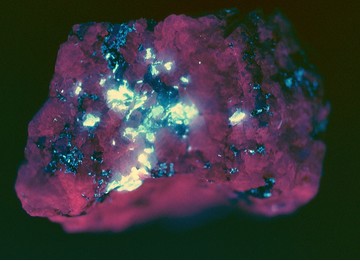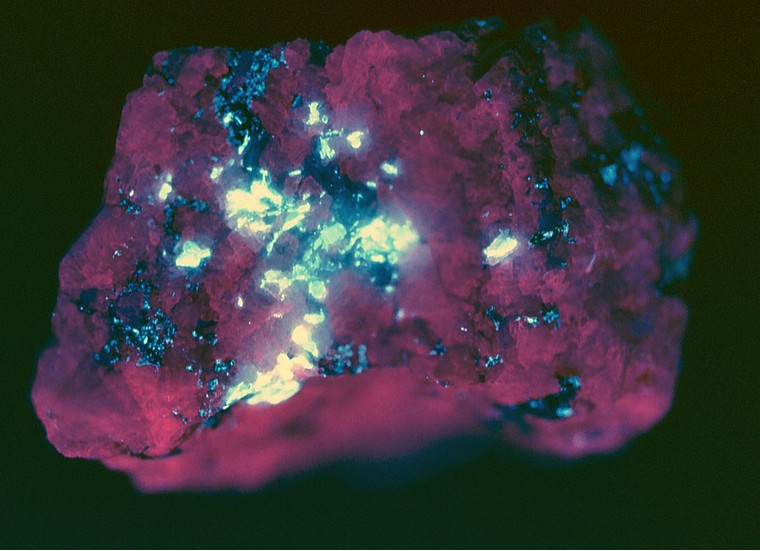Katayamalite
A valid IMA mineral species
This page is currently not sponsored. Click here to sponsor this page.
About Katayamalite
Formula:
KLi3Ca7Ti2(SiO3)12(OH)2
Colour:
Colorless, wWhite
Lustre:
Vitreous
Hardness:
3½ - 4
Specific Gravity:
2.91
Crystal System:
Monoclinic
Name:
Named in honor of Nobuo Katayama (片山信夫) (17 January 1910, Tokyo, Japan - 4 March 1997), mineralogist and professor at the Tokyo Imperial University and later at Kyushu University.
Type Locality:
Described as the hydroxyl analogue of baratovite, which had originally been described as fluor-dominant. Some mineralogists now claim that baratovite is also hydroxyl- rather than fluor-dominant, and that baratovite and katayamalite are therefore the same species, with the name baratovite having priority. At present this situation has not been clarified and katayamalite remains an IMA-approved species.
Originally described as having a triclinic symmetry (space group C-1) by Kato & Murakami (1985). The structure was redetermined with monoclinic symmetry (space group C2/c) by Andrada et al. (2013).
Originally described as having a triclinic symmetry (space group C-1) by Kato & Murakami (1985). The structure was redetermined with monoclinic symmetry (space group C2/c) by Andrada et al. (2013).
Unique Identifiers
Mindat ID:
4716
Long-form identifier:
mindat:1:1:4716:2
GUID
(UUID V4):
(UUID V4):
060b87ae-8dfc-452e-8846-034fec34401f
IMA Classification of Katayamalite
Classification of Katayamalite
9.CJ.25
9 : SILICATES (Germanates)
C : Cyclosilicates
J : [Si6O18]12- 6-membered single rings (sechser-Einfachringe), without insular complex anions
9 : SILICATES (Germanates)
C : Cyclosilicates
J : [Si6O18]12- 6-membered single rings (sechser-Einfachringe), without insular complex anions
Mineral Symbols
As of 2021 there are now IMA–CNMNC approved mineral symbols (abbreviations) for each mineral species, useful for tables and diagrams.
| Symbol | Source | Reference |
|---|---|---|
| Kyl | IMA–CNMNC | Warr, L.N. (2021). IMA–CNMNC approved mineral symbols. Mineralogical Magazine, 85(3), 291-320. doi:10.1180/mgm.2021.43 |
Pronunciation of Katayamalite
Pronunciation:
| Play | Recorded by | Country |
|---|---|---|
| Jolyon Ralph | United Kingdom |
Physical Properties of Katayamalite
Vitreous
Transparency:
Transparent
Colour:
Colorless, wWhite
Streak:
White
Hardness:
3½ - 4 on Mohs scale
Cleavage:
Perfect
{001}
{001}
Density:
2.91(2) g/cm3 (Measured) 2.899 g/cm3 (Calculated)
Chemistry of Katayamalite
Mindat Formula:
KLi3Ca7Ti2(SiO3)12(OH)2
Crystallography of Katayamalite
Crystal System:
Monoclinic
Class (H-M):
2/m - Prismatic
Space Group:
B2/b
Setting:
C2/c
Cell Parameters:
a = 16.9093(10) Å, b = 9.7287(5) Å, c = 20.9019(12) Å
β = 112.396(3)°
β = 112.396(3)°
Ratio:
a:b:c = 1.738 : 1 : 2.148
Unit Cell V:
3,179.12 ų (Calculated from Unit Cell)
Z:
4
Morphology:
Platy.
Twinning:
Parallel twinning with composition plane {001} is common.
Crystal Structure
Load
Unit Cell | Unit Cell Packed
2x2x2 | 3x3x3 | 4x4x4
Unit Cell | Unit Cell Packed
2x2x2 | 3x3x3 | 4x4x4
Show
Big Balls | Small Balls | Just Balls | Spacefill
Polyhedra Off | Si Polyhedra | All Polyhedra
Remove metal-metal sticks
Big Balls | Small Balls | Just Balls | Spacefill
Polyhedra Off | Si Polyhedra | All Polyhedra
Remove metal-metal sticks
Display Options
Black Background | White Background
Perspective On | Perspective Off
2D | Stereo | Red-Blue | Red-Cyan
Black Background | White Background
Perspective On | Perspective Off
2D | Stereo | Red-Blue | Red-Cyan
View
CIF File Best | x | y | z | a | b | c
CIF File Best | x | y | z | a | b | c
Rotation
Stop | Start
Stop | Start
Labels
Console Off | On | Grey | Yellow
Console Off | On | Grey | Yellow
Data courtesy of the American Mineralogist Crystal Structure Database. Click on an AMCSD ID to view structure
| ID | Species | Reference | Link | Year | Locality | Pressure (GPa) | Temp (K) |
|---|---|---|---|---|---|---|---|
| 0019864 | Katayamalite | Andrade M B, Doell D, Downs R T, Yang H (2013) Redetermination of katayamalite, KLi3Ca7Ti2(SiO3)12(OH)2 Acta Crystallographica E69 i41-i41 |  | 2013 | Iwagi Island, Inland Sea, Ehime Prefecture, Japan | 0 | 293 |
| 0014425 | Katayamalite | Kato T, Murakami N (1985) The crystal structure of katayamalite Mineralogical Journal 12 206-217 |  | 1985 | Iwagi Islet, Ehime Prefecture, Japan | 0 | 293 |
CIF Raw Data - click here to close
X-Ray Powder Diffraction
Powder Diffraction Data:
| d-spacing | Intensity |
|---|---|
| 3.48 Å | (20) |
| 3.30 Å | (20) |
| 3.23 Å | (100) |
| 3.06 Å | (30) |
| 2.943 Å | (30) |
| 2.898 Å | (30) |
| 2.790 Å | (20) |
| 2.417 Å | (30) |
| 1.933 Å | (40) |
| 1.841 Å | (25) |
| 1.382 Å | (25) |
Comments:
Murakami et al 1983 (type description).
Geological Environment
Paragenetic Mode(s):
| Paragenetic Mode | Earliest Age (Ga) |
|---|---|
| Near-surface Processes | |
| 21 : Chemically precipitated carbonate, phosphate, iron formations |
Type Occurrence of Katayamalite
General Appearance of Type Material:
Single crystals, twinned or granular aggregates, with individual grains being 0.01-0.2 x 0.1-0.5 mm in size.
Place of Conservation of Type Material:
Yamaguchi University, National Science Museum, Tokyo, Japan.
Sakurai Museum, Tokyo, Japan.
Sakurai Museum, Tokyo, Japan.
Geological Setting of Type Material:
A fine-grained accessory mineral in aegirine syenite, 0.3-0.5% by volume.
Associated Minerals at Type Locality:
Synonyms of Katayamalite
Other Language Names for Katayamalite
Common Associates
Associated Minerals Based on Photo Data:
Related Minerals - Strunz-mindat Grouping
| 9.CJ. | Avdeevite | NaAl4(Be5Li)(Si6O18)2(H2O)1-2 |
| 9.CJ. | Nakkaalaaqite | K2[Na3Ca]LiCa2Ti2Be4Si12O38 |
| 9.CJ. | Zolotarevite | Na5Zr[Si6O15(OH)3] · 3H2O |
| 9.CJ. | Beryllocordierite-Na | NaMg4(Al5Be)(AlSi5O18)2 · 2H2O |
| 9.CJ. | Beryllosachanbińskiite-Na | NaMn4(Al5Be)(AlSi5O18)2 · 2H2O |
| 9.CJ.05 | Bazzite | Be3Sc2(Si6O18) |
| 9.CJ.05 | Beryl | Be3Al2(Si6O18) |
| 9.CJ.05 | Indialite | Mg2Al3(AlSi5O18) |
| 9.CJ.05 va | Vorobyevite | Be3Al2(Si6O18) |
| 9.CJ.05 | Stoppaniite | Be3Fe3+2(Si6O18) · H2O |
| 9.CJ.05 | Ferroindialite | (Fe2+,Mg)2Al4Si5O18 |
| 9.CJ.05 | Johnkoivulaite | Cs[Be2B]Mg2Si6O18 |
| 9.CJ.10 | Cordierite | (Mg,Fe)2Al3(AlSi5O18) |
| 9.CJ.10 | Sekaninaite | (Fe,Mg)2Al3(AlSi5O18) |
| 9.CJ.15a | Combeite | Na4.5Ca3.5Si6O17.5(OH)0.5 |
| 9.CJ.15b | Imandrite | Na12Ca3Fe3+2(Si6O18)2 |
| 9.CJ.15a | Kazakovite | Na6Mn2+Ti(Si6O18) |
| 9.CJ.15c | Koashvite | Na6(Ca,Mn)(Ti,Fe)Si6O18 · H2O |
| 9.CJ.15a | Lovozerite | Na2Ca(Zr,Ti)(Si6O12)[(OH)4O2] · H2O |
| 9.CJ.15a | Tisinalite | Na3H3(Mn,Ca,Fe)TiSi6(O,OH)18 · 2H2O |
| 9.CJ.15a | Zirsinalite | Na6(Ca,Mn2+,Fe2+)Zr(Si6O18) |
| 9.CJ.15a | Litvinskite | Na2(◻,Na,Mn)ZrSi6O12(OH,O)6 |
| 9.CJ.15a | Kapustinite | Na6ZrSi6O16(OH)2 |
| 9.CJ.15a | Townendite | Na8ZrSi6O18 |
| 9.CJ.25 | Baratovite | KCa7(Ti,Zr)2Li3Si12O36F2 |
| 9.CJ.25 | Aleksandrovite | KCa7Sn2Li3Si12O36F2 |
| 9.CJ.30 | Dioptase | CuSiO3 · H2O |
| 9.CJ.35 | Kostylevite | K2Zr(Si3O9) · H2O |
| 9.CJ.40 | Petarasite | Na5Zr2(Si6O18)(Cl,OH) · 2H2O |
| 9.CJ.45 | Gerenite-(Y) | (Ca,Na)2(Y,REE)3Si6O18 · 2H2O |
| 9.CJ.50 | Odintsovite | K2Na4Ca3Ti2Be4Si12O38 |
| 9.CJ.55 | Mathewrogersite | Pb7FeAl3GeSi12O36(OH,H2O)6 |
| 9.CJ.60 | Pezzottaite | Cs(Be2Li)Al2(Si6O18) |
Fluorescence of Katayamalite
Brilliant blue-white under SW-UV.
Other Information
Health Risks:
No information on health risks for this material has been entered into the database. You should always treat mineral specimens with care.
Internet Links for Katayamalite
mindat.org URL:
https://www.mindat.org/min-4716.html
Please feel free to link to this page.
Please feel free to link to this page.
Search Engines:
External Links:
Mineral Dealers:
References for Katayamalite
Reference List:
Murakami, Nobuhide, Kato, Toshio, Hirowatari, Fumitoshi (1983) Katayamalite, a new Ca-Li-Ti silicate mineral from Iwagi Islet, Southwest Japan. Mineralogical Journal, 11 (6) 261-268 doi:10.2465/minerj.11.261
Dunn, Pete J., Fleischer, Michael, Francis, Carl A., Langley, Richard H., Kissin, Stephen A., Shigley, Hames E., Vanko, David A., Zilczer, Janet A. (1984) New mineral names. American Mineralogist, 69 (7-8) 810-815
Kato, Toshio, Murakami, Nobuhide (1985) The crystal structure of katayamalite. Mineralogical Journal, 12 (5) 206-217 doi:10.2465/minerj.12.206
Localities for Katayamalite
Locality List
 - This locality has map coordinates listed.
- This locality has map coordinates listed.
 - This locality has estimated coordinates.
ⓘ - Click for references and further information on this occurrence.
? - Indicates mineral may be doubtful at this locality.
- This locality has estimated coordinates.
ⓘ - Click for references and further information on this occurrence.
? - Indicates mineral may be doubtful at this locality.
 - Good crystals or important locality for species.
- Good crystals or important locality for species.
 - World class for species or very significant.
(TL) - Type Locality for a valid mineral species.
(FRL) - First Recorded Locality for everything else (eg varieties).
- World class for species or very significant.
(TL) - Type Locality for a valid mineral species.
(FRL) - First Recorded Locality for everything else (eg varieties).
All localities listed without proper references should be considered as questionable.
Japan (TL) | |
| Murakami et al. (1983) +3 other references |
| Imaoka et al. (2021) | |
Kyrgyzstan | |
| Pautov et al. (2013) |
Quick NavTopAbout KatayamaliteUnique IdentifiersIMA Classification Classification Mineral SymbolsPronunciation Physical Properties Chemistry Crystallography Crystal StructureX-Ray Powder DiffractionGeological EnvironmentType Occurrence SynonymsOther LanguagesCommon AssociatesStrunz-MindatFluorescence Other InformationInternet Links References Localities Locality List






 symbol to view information about a locality.
The
symbol to view information about a locality.
The 



Iwagi Island, Ochi District, Ehime Prefecture, Japan